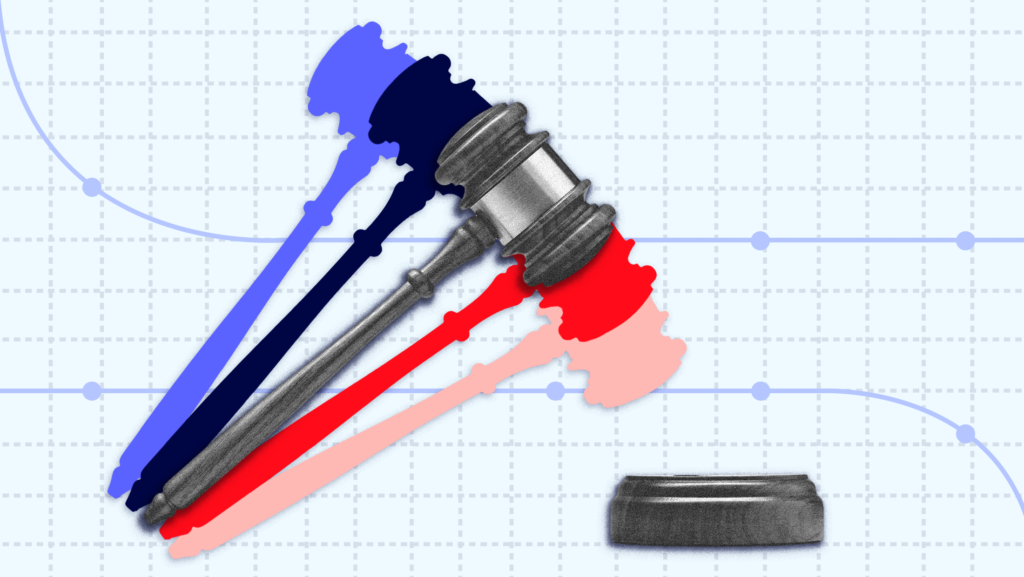State Supreme Courts Don’t Match America’s Diversity

State Supreme Courts are often overlooked in favor of the U.S. Supreme Court, which decides high-profile constitutional issues and is subject to acrimonious confirmation fights. But state Supreme Courts may have a bigger influence over Americans’ day-to-day lives, as 95% of cases filed in the United States are heard in state courts and state Supreme Courts have the final word in setting precedent for more than 23,000 lower state court judges.
One important factor impacting how state Supreme Courts function is their diversity. Research shows that having a diverse judiciary enriches judicial decision-making and promotes public confidence in a court’s legitimacy. In today’s Data Dive, we’re taking a look at the demographic and professional characteristics of state Supreme Court justices. Earlier this year, the Brennan Center surveyed their diversity, an update to previous research in 2019 and 2020. The report, “State Supreme Court Diversity,” found that state Supreme Courts continue to fail to reflect the diversity of their states and of the legal profession.
Here are the key takeaways:
Court demographics have only marginally changed since 2020.
The Brennan Center last surveyed the diversity of state Supreme Courts in February 2020. Between then and April 2021 (when this report was published), 41 new justices took office. Some of the more notable new justices include:
- Melissa Long, the first Black justice in Rhode Island.
- Martin Jenkins, the first openly gay justice in California, as well as the third Black justice and the first Black man in nearly three decades.
- Fabiana Pierre-Louis, the first Black female justice in New Jersey.
- Carla Wong McMillan, the first Asian American justice in Georgia and the first in any southern state.
Despite these important milestones, the overall demographics of state Supreme Courts did not change much since most of the new justices are white and male. Nationally, the percentage of justices of color increased by only two percentage points from 15% to 17%. The percentage of female justices increased by three points from 36% to 39%.
State Supreme Courts lag behind the country in racial, ethnic and gender diversity.
Even though America is becoming increasingly diverse, state Supreme Courts don’t reflect this. Nationwide, only 17% of state Supreme Court justices identify as people of color, even though people of color make up nearly 40% of the population. Representation of women, almost 100 years after Florence Ellen became the first female state Supreme Court justice, also lags behind the female share of the population. Women currently hold 39% of state Supreme Court seats despite accounting for slightly more than half of the population. The disparity is even starker on a state-by-state basis. 22 states do not have any justices that identify as a person of color — including 11 states where people of color make up at least 20% of the population. While every state has at least one female justice, 12 states have only one.
Delving into the representation of specific minority communities is even more illuminating. There are no Latinx justices in 12 states where Latinx residents make up at least 10% of the population. Similarly, eight states where Black residents make up at least 10% of the population lack a Black justice — including states like Alabama and Florida with significant legacies of racial discrimination.
Additionally, Native Americans and Asian Americans are the least-represented demographic groups, with no Asian American justices in 44 states and no Native American justices in 47 states. Three of the four states with the largest Native American populations — Arizona, California and Texas — do not have any Native American justices. Likewise, New Jersey, New York and Texas lack any Asian American justices despite numbering in the top five of states by Asian population.
Few justices have backgrounds in public defense or civil legal services.
Demographic diversity isn’t the only kind of diversity that matters in our courts. Having diverse professional backgrounds can inform justices’ perspectives on legal issues and influence how their decisions develop the law. President Biden, for instance, has prioritized increasing professional diversity in the federal judiciary by appointing more public defenders and civil rights advocates. But there has been comparatively less attention paid to the experiences of state Supreme Court justices. In this year’s report, the Brennan Center reviewed the professional background of every sitting justice for the first time.
The most common professional backgrounds were working in private practice (81%), another judgeship (68%) and as a prosecutor (37%). Like the federal bench, experience as public defenders or in civil legal services (representing low-income clients in matters like evictions) is much less common at only 7% and 2% respectively. Indeed, there are more justices named John (13) than there are with civil legal service experience (seven). And while 43 states have at least one former prosecutor on the bench, just 19 have a former public defender.
The report also found variance in professional backgrounds between justices of different racial and ethnic backgrounds. White justices are more likely to have experience in private practice, reflecting a broader trend in the legal profession. Interestingly, justices of color are more likely to have prior experience as a prosecutor than white justices, despite 95% of prosecutors nationally being white.
As the report demonstrates, the composition of the state Supreme Court bench has a long way to go until it reflects the diversity of our nation. Unfortunately, there’s no easy solution. Unlike the federal judiciary, state Supreme Court justices are selected in a myriad of ways, such as statewide elections or appointment by the governor. It will take a concerted effort on the part of many to ensure state Supreme Courts are as diverse as the populations they represent.